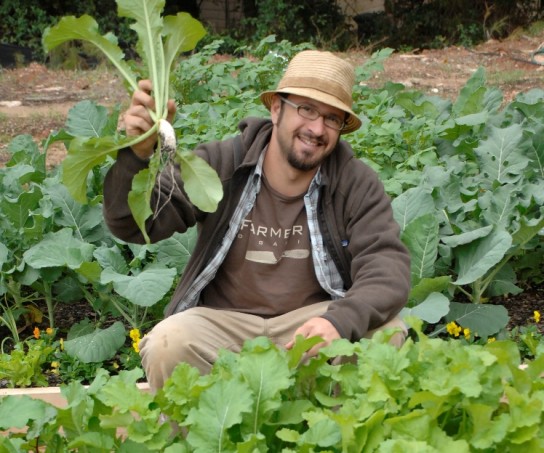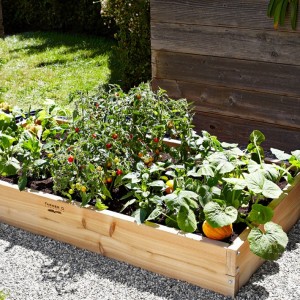 Williams-Sonoma collaborated with Daron Joffe of Farmer D Organics on our new Agrarian collection, featuring his raised bed kits for edible gardening and window boxes for urban gardeners, among other environmentally conscious farm and garden products. We asked Joffe for some of his best tips for beginners starting a home garden, so read on to learn the best places to plant, how to water and how to make the most of your bounty.
Williams-Sonoma collaborated with Daron Joffe of Farmer D Organics on our new Agrarian collection, featuring his raised bed kits for edible gardening and window boxes for urban gardeners, among other environmentally conscious farm and garden products. We asked Joffe for some of his best tips for beginners starting a home garden, so read on to learn the best places to plant, how to water and how to make the most of your bounty.
Maybe the sight of all those heirloom tomatoes at the farmers’ market (plus the sticker-shock prices) has you thinking, “I wonder if I can do that.” Maybe your children are gardening at school and want to try it at home. Maybe your friends and neighbors are making you green with envy (however nice they are about sharing) with their gorgeous garden bounty. Or maybe you grew up with a garden, or liked visiting your grandmother’s, and just plain miss it. No matter what has brought you to this point, you’re eyeing your backyard and imagining the possibilities.
Here’s a quick list of tips to get you going, or should I say, growing.
Follow the sun. Make sure you have a solid 6 to 8 hours of sun a day, and that your garden is situated to take advantage of it (south facing seems to work best). And, guess what? There’s even an app for that! When I do site surveys for new home, school, faith-based, community or city garden installations, I determine the amount of sunlight available for a location with SunSeeker. It’s about $4.99 for the full version and worth every penny. The other option is take a “sun” day and sit back with fresh tea from the garden, a notepad and a clock and do it the old-fashioned way: sit, watch and observe. Nice.
In all honesty, the search for the sun is what leads many people to their side or front yards, or even all the way to their local community garden (or inspires them to start one). Before you rule out the shady parts of your property, consider pruning trees to let in more sunlight, or even adding a “mailbox garden,” as curbside mailboxes are typically in unobstructed spots. Be sure nothing blocks the mail carrier, and as a goodwill gesture, let him or her know the cherry tomatoes are there for sampling. My 3-foot sustainable cedar raised bed is perfect for this purpose.
 Start with good soil. If you focus on growing good soil, your soil will grow good food. A healthy base for gardening requires the right balance of fluffy soil (so that air and water can get to plant roots), organic matter, and the necessary nutrients. A soil test performed by your local cooperative extension service will tell you exactly what you need so that you don’t waste a whole growing season having disappointing results while you try to get it right. Ask to have the results converted to organic recommendations if your extension service doesn’t automatically do this. Consider my organic planting mix and custom-blended fertilizer to get the perfect balance right away.
Start with good soil. If you focus on growing good soil, your soil will grow good food. A healthy base for gardening requires the right balance of fluffy soil (so that air and water can get to plant roots), organic matter, and the necessary nutrients. A soil test performed by your local cooperative extension service will tell you exactly what you need so that you don’t waste a whole growing season having disappointing results while you try to get it right. Ask to have the results converted to organic recommendations if your extension service doesn’t automatically do this. Consider my organic planting mix and custom-blended fertilizer to get the perfect balance right away.
Water sufficiently. Your new veggie garden needs a steady supply of water, especially when you first plant seeds or add transplants. After that, you’re looking at about an inch a week. Consider how you are going to water when you choose your location. The mailbox garden can get by with hand-watering using a sturdy watering can, but bigger gardens present some challenges, especially if you live in a drought-prone area or your schedule is erratic. You may want to add drip irrigation when you install your garden. It delivers water right to the roots, where it’s needed. It keeps water from splashing on leaves, which leads to disease. It also conserves water and can be put on a timer for regular delivery of this key resource. If you choose to hand-water with a hose, aim for early morning or early evening so that you don’t lose water to evaporation in the heat of the day.
Choose crops you like. One of the major joys of home gardening is choosing what you want to plant based on your family’s specific needs, preferences and reason for gardening in the first place. Do you want your children to see how things grow from seed to table? Do you want to save money at the supermarket or simplify dinner preparation by walking outside and snipping a couldn’t-be-fresher salad? Do you want to have a personal hand in preserving heirloom seed varieties? Do you simply crave a still-warm-from-the-sun tomato or a bursting-with-flavor blackberry?
You will learn over time what you and your family really appreciate and what seems to be worth the effort, but give it some thought from the get-go to increase the chances of a satisfying gardening experience.
Pay attention. Gardens are alive and they require care. That sentence may sound very simplistic, but it’s very common for gardens to become abandoned pretty quickly just because they don’t wag their tails and demand attention. Try to consciously dedicate even just a few minutes a day to checking the garden, noticing the changes from the day before and identifying what may become a problem.
For instance, the dreaded tomato hornworm can destroy your beloved tomato plant in one quick day of aggressive leaf-chomping, but if you find the culprit early simply by paying attention, you can just lift it off the stem and drop it in soapy water (or feed it to your chickens). It’s really as easy as that. You will most likely find that a quick walk through the garden serves as a bit of meditation time as well, and you will grow to love it (or at least, I do).
Appreciate your bounty. On the day you harvest your first jalapeño or when you finally slice open that heirloom watermelon after waiting for months, you really do want to take a moment to appreciate your achievement. If that means having a celebratory grilling of the first zucchini, fire up the grill. If it means shooting photos and posting them all over Facebook, shoot away. If it means simply taking a moment to be thankful, that moment matters. Enjoy. You grew it. You earned it.
See Farmer D Organics for more growing tips, and be sure to follow us on Facebook. I’d love to see photos of what your garden produces this year.

1 comment
[…] 6 Tips for Starting a Home Garden […]